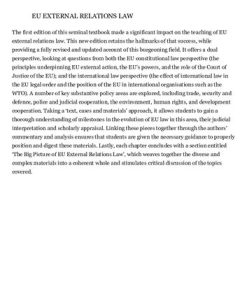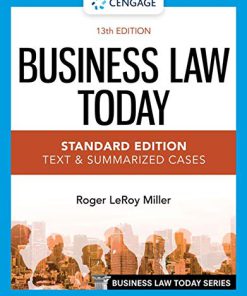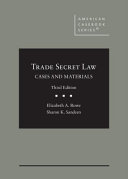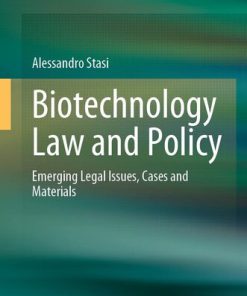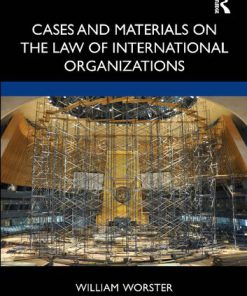International Law Text Cases and Materials 2nd Edition by Ademola Abass 019967907X 9780199679072
$50.00 Original price was: $50.00.$25.00Current price is: $25.00.
International Law Text Cases and Materials 2nd Edition by Ademola Abass – Ebook PDF Instant Download/Delivery: 019967907X, 9780199679072
Full download International Law Text Cases and Materials 2nd Edition after payment

Product details:
ISBN 10: 019967907X
ISBN 13: 9780199679072
Author: Ademola Abass
Complete International Law combines a wide range of case extracts with incisive author commentary to clearly demonstrate legal principles and the significance of case law. This innovative text encourages an active approach to learning with key point summaries, thinking points and self-test questions throughout; which aim to stimulate reflection about the importance of international law in today’s world. Online Resource Centre An Online Resource Centre, containing the following resources for students and lecturers accompanies this book. For students: Appendices Guidance on answering discussion questions Flashcard glossary of key terms Annotated weblinks For lecturers: A testbank of multiple choice questions
International Law Text Cases and Materials 2nd Table of contents:
Chapter 1 International law in the modern context
1.1 A brief history of international law: a distinction between the ‘origin’ and ‘documentati
1.2 The meaning and concept of international law
1.3 The nature of international law: theories
1.4 The relationship of theories of law with international law
1.5 The basis of international law: consent
1.6 The functions of international law
1.7 What next in international law?
Conclusion
Questions
Key case
Further reading
Chapter 2 Sources of international law
2.1 What does the phrase ‘sources of law’ mean?
2.2 ‘Formal’, ‘material’, and ‘functional’ sources of law
2.3 What are the sources of international law?
2.4 Treaties
2.5 Customs
2.6 General principles of law
2.7 Judicial decisions
2.8 The writings of publicists
2.9 The relationship between sources of international law
2.10 Are there other sources of international law?
Conclusion
Questions
Key cases
Further reading
Chapter 3 The law of treaties
3.1 General issues: the definition, scope, and nature of treaties
3.2 The scope of the Vienna Convention on the Law of Treaties
3.3 The nature of treaties
3.4 Procedural obligations of treaties
3.5 The reservation of treaties
3.6 The interpretation of treaties
3.7 Invalid treaties
3.8 The termination and suspension of treaties
Conclusion
Questions
Key cases
Further reading
Chapter 4 Statehood and recognition in international law
4.1 Legal personality of States
4.2 The status of international legal persons
4.3 States as a subject of international law
4.4 Lesser States and special territories
4.5 International organizations
4.6 Individuals
4.7 The recognition of States and governments
Conclusion
Questions
Key cases
Further reading
Chapter 5 International organizations
5.1 Origins: from the Congress of Vienna to the League of Nations
5.2 Definitions
5.3 Classification: international (governmental) organizations, international (non-governmental) org
5.4 Features of international organizations
5.5 The operation of legal personality
5.6 Privileges and immunity
Conclusion
Questions
Key cases
Further reading
Chapter 6 Territory and the law of the sea
6.1 The modes of acquiring territory
6.2 Occupation and prescription
6.3 Cession and accretion
6.4 The law of the sea
6.5 The codification of the law of the sea: 1930
6.6 The 1958 and 1960 UN Conference on the Law of the Sea (UNCLOS I and II)
6.7 The 1982 UN Convention on the Law of the Sea (UNCLOS III)
Conclusion
Questions
Key cases
Further reading
Chapter 7 Jurisdiction
7.1 The meaning and nature of jurisdiction
7.2 The territoriality principle
7.3 The ‘effect’ doctrine
7.4 The nationality principle
7.5 The protective principle
7.6 The universality principle
7.7 The passive personality principle
7.8 Problems of illegal enforcement jurisdiction
Conclusion
Questions
Key cases
Further reading
Chapter 8 Immunity
8.1 The nature of immunity
8.2 The rationale behind immunity
8.3 State immunity
8.4 Distinguishing between absolute and restrictive immunity
8.5 International crimes and State immunity
8.6 Individual immunity
8.7 Immunities before international tribunals and courts
8.8 Diplomatic and consular immunities
8.9 Diplomatic missions
Conclusion
Questions
Key cases
Further reading
Chapter 9 International law and municipal law
9.1 International and municipal law: what relationship?
9.2 Municipal law issues under international law
9.3 International legal issues before municipal legal systems
9.4 The transformation of treaties into municipal law
Conclusion
Questions
Key cases
Further reading
Chapter 10 The law of use of force
10.1 The League of Nations and the Kellogg–Briand Pact
10.2 The UN Charter and the prohibition of the use and threat of force
10.3 Exceptions to the prohibition of the use of force
10.4 Is Article 2(4) sufficient in the modern world?
Conclusion
Questions
Key cases
Further reading
Chapter 11 Collective security
11.1 The meaning of ‘collective security’
11.2 Collective security in a modern world
11.3 Collective security under the League of Nations
11.4 The scope of, and authority for, collective security
11.5 The United Nations and collective security
11.6 Regional collective security systems
11.7 The distinction between ‘collective security’ and ‘collective self-defence’
11.8 Peacekeeping
11.9 Humanitarian intervention
11.10 Responsibility to protect
Conclusion
Questions
Further reading
Chapter 12 International humanitarian law
12.1 Background
12.2 International customary law and the codification of IHL
12.3 Customary international law and IHL
12.4 When does an armed conflict occur?
12.5 Armed conflict classification and the war on terror
12.6 Combatants, civilians, and somewhere in between: the principle of distinction
12.7 Restricting methods of warfare through the distinction and proportionality and control of weap
12.8 Civilian objects and military objectives
12.9 Regulating weapons
12.10 The International Committee of the Red Cross and its role
Conclusion
Questions
Key cases
Further reading
Chapter 13 State responsibility
13.1 The International Law Commission
13.2 Determining the internationally wrongful acts of a State
13.3 Attribution of acts or omissions to States
13.4 Theories of imputability
13.5 Enforcing responsibility against delinquent States
13.6 Circumstances precluding wrongfulness
13.7 Peremptory norms: breaches that can never be excused (Aricle 26 ARSIWA)
Conclusion
Questions
Key cases
Further reading
Chapter 14 The settlement of international disputes
14.1 What is a dispute?
14.2 The peaceful settlement of disputes
14.3 Negotiation, inquiry, mediation, good offices, and conciliation
14.4 Arbitration
Conclusion
Questions
Key cases
Further reading
Chapter 15 The International Court of Justice
15.1 A short history of the Court
15.2 The functions of the ICJ
15.3 Access to the Court
15.4 The composition, election, and retirement of judges of the ICJ
15.5 The independence of the Court
15.6 The jurisdiction of the ICJ
15.7 The effects of a declaration under Article 36(2)
15.8 The conditions of declaration
15.9 Types of reservation
15.10 Interventions
15.11 Advisory opinions
15.12 Consent and advisory opinion
15.13 The effects of ICJ judgments
Conclusion
Questions
Key cases
Further reading
Chapter 16 International criminal law
16.1 What is international criminal law and how did it develop?
16.2 Sources, nature, and scope of international criminal law
16.3 The distinction between State and individual responsibility
16.4 General principles of international criminal law
16.5 International criminal tribunals
16.6 The International Criminal Court (ICC)
16.7 International crimes
16.8 Immunity
Conclusion
Questions
Key cases
Further reading
Chapter 17 International environmental law
17.1 What is international environmental law?
17.2 The development of international environmental law: a short history
17.3 Sources of international environmental law
17.4 Major international efforts towards international regulation of the environment
17.5 Enforcement of international environmental law
Conclusion
Questions
Key cases
Further reading
Chapter 18 International economic law
18.1 The origins and nature of international economic law
18.2 International economic law and public international law
18.3 Institutional mechanisms for regulating international economic law
18.4 International finance law
18.5 The World Bank’s Inspection Panel
Conclusion
Questions
Key cases
Further reading
Chapter 19 International human rights
19.1 States and human rights
19.2 The rise of international human rights
19.3 The United Nations and human rights
19.4 Regional human rights systems
19.5 Regional human rights courts
19.6 Current issues in international human rights law
People also search for International Law Text Cases and Materials 2nd:
international investment law text cases and materials 2nd ed
q&a constitutional law i
nternational law text cases and materials
4 international crimes
Tags:
Ademola Abass,International,Law,Materials
You may also like…
Jurisprudence & Law
EU External Relations Law: Text, Cases and Materials 2nd Edition Ramses A Wessel
Jurisprudence & Law - Foreign & International Law
Commercial & Financial Law
Business Law Today, Standard Edition: Text & Summarized Cases, 13e Roger Leroy Miller
Commercial & Financial Law
Commercial & Financial Law
Trade Secret Law: Cases and Materials (American Casebook Series) 3rd Edition Rowe
Jurisprudence & Law - Criminal Law & Procedure
Waller & Williams Criminal Law Text and Cases 14th Edition Dr. Tyrone Kirchengast
Jurisprudence & Law - Foreign & International Law
Jurisprudence & Law - Environmental Law
Politics & Philosophy - Social Sciences
Cases and Materials on the Law of International Organizations 1st Edition William Thomas Worster



